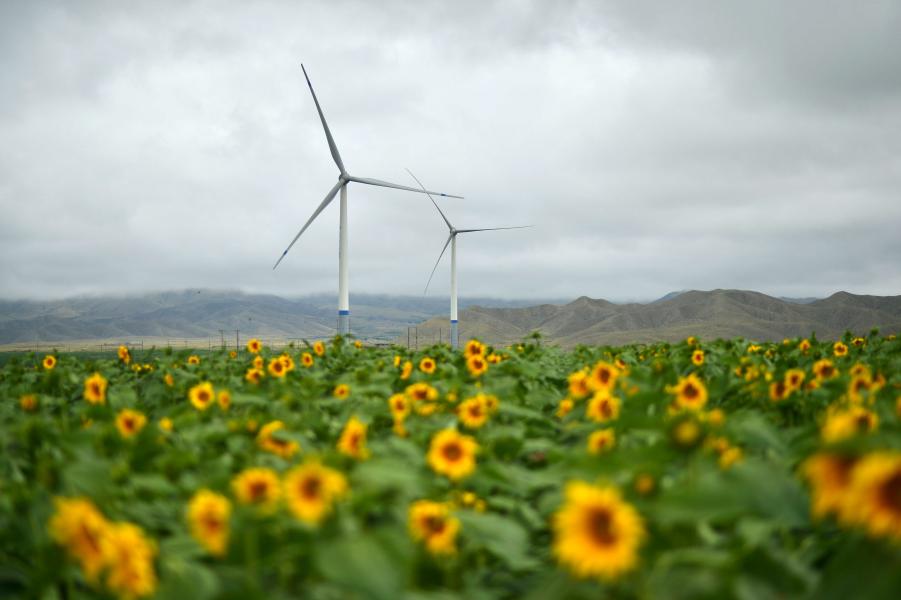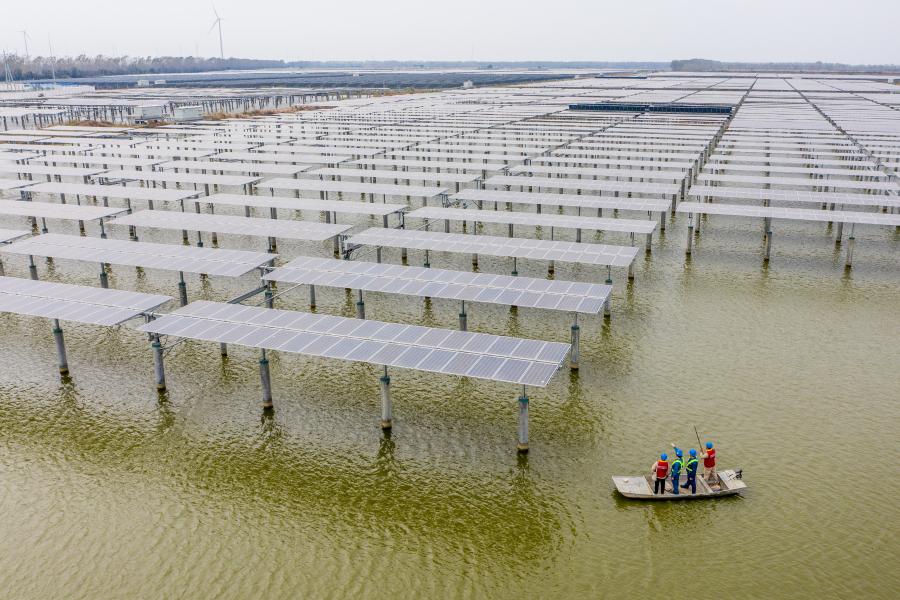Low-carbon revolution sweeps through China for green, better future
China, the world's largest energy producer and consumer, on Monday issued a white paper on its energy development, elaborating how the world's second largest economy is sailing toward a greener future.
China, the world's largest energy producer and consumer, on Monday issued a white paper on its energy development, elaborating how the world's second largest economy is sailing toward a greener future.
Titled "Energy in China's New Era," the white paper was released by the State Council Information Office to provide a full picture of China's achievements in energy development and major policies for energy reform.

Photo taken on Aug. 13, 2019 shows wind turbines amid blooming sunflowers in Sitan Township of Jingtai County in Baiyin, northwest China's Gansu Province. [Photo/Xinhua]
China has been working on all fronts to reform the ways energy is consumed, to build a clean and diversified energy supply system, to implement an innovation-driven energy strategy, to further the reform of the energy system, and to enhance international energy cooperation, the document says.
"Facing increasingly severe global problems such as climate change, environmental risks and challenges, and energy and resource constraints, China embraces the vision of a global community of shared future and accelerates its transformation towards green and low-carbon development in economy and society," it says.
Go low-carbon, go green
While securing blistering economic growth over the past 40-plus years since reform and opening up, China has also realized historic achievements in energy development, with growing energy supply capacity and optimized energy consumption structure.
Preliminary calculations show that China's primary energy production in 2019 reached 3.97 billion tonnes of standard coal, making it the world's largest energy producer.
"Its transition to efficient energy utilization has also been the fastest in the world," says the document, adding that China gives priority to non-fossil energy, and strives to substitute low-carbon for high-carbon energy and renewable for fossil energy.
It has been a tough choice for China, especially at a time when the economy is facing headwinds. However, it has stood steadfast in resisting the old way of economic expansion at the cost of the environment as the leadership has repeatedly underscored that "lucid waters and lush mountains are invaluable assets."
Since 2012, energy consumption per unit of GDP has been reduced by 24.4 percent, equivalent to 1.27 billion tonnes of standard coal.
By 2019, carbon emission intensity had decreased by 48.1 percent compared with 2005, which exceeded the target of reducing carbon emission intensity by 40 percent to 45 percent between 2005 and 2020, reversing the trend of rapid carbon dioxide emission growth.
In contrast, its total installed capacity of power generation using renewable energy resources reached 790 million kilowatts as of the end of 2019, accounting for about 30 percent of the global total.
According to the white paper, China has invested 818 billion U.S. dollars in new energy power generation since 2010, accounting for 30 percent of the global total over the same period.

Electricians check photovoltaic solar panels in Sheyanghu Township of Baoying County, east China's Jiangsu Province, Nov. 5, 2020. [Photo/Xinhua]
Last year, clean energy (natural gas, hydropower, nuclear power, wind power) accounted for 23.4 percent of China's total energy consumption, up 8.9 percentage points over 2012, preliminary calculations showed.
"With this China has reached the target of raising the share of non-fossil energy to 15 percent in total energy consumption by 2020," the white paper says, adding that China will scale up its Intended Nationally Determined Contributions, striving to have carbon dioxide emissions peak before 2030 and to achieve carbon neutrality before 2060.
Shared future for all
Holding that energy matters to the survival and development of humanity, China, as a staunch supporter of multilateralism, has become an active participant in global energy governance.
According to the document, China has set up intergovernmental energy cooperation mechanisms with over 90 countries and regions, and established ties with over 30 international organizations and multilateral mechanisms in the energy sector.
Since 2012, the country has become a member state of the International Renewable Energy Agency, an observer country to the Energy Charter Treaty, and an affiliate of the International Energy Agency, it says.
While engaging in multilateral energy governance, China has greatly eased market access for foreign investment to enter the sectors of coal, oil, gas, electricity which excludes nuclear power, and new energy, and has built a market-based international business environment that respects the rule of law to facilitate free trade and investment.
International energy companies such as ExxonMobil, GE, BP, EDF and SIEMENS are steadily expanding investment in China, according to the white paper. "The wide application of renewable energy technologies in the Chinese market is helping to reduce the cost of renewable energy and accelerate the green transition process across the globe," it says.
With a batch of landmark energy projects such as China-Russia, China-Central Asia and China-Myanmar oil and gas pipelines brought into operation and China's power grids connected to the grids of seven neighboring countries, China has given a strong boost to energy infrastructure connectivity and realized optimal allocation of energy resources on a larger scale, which facilitates economic cooperation within the region, according to the white paper.
China will work together with all countries to expand cooperation on global energy governance, promote the sustainable development of global energy, and protect global energy security.
"This is part of our commitment to realizing more inclusive, balanced and equal development for all, and to building a clean, beautiful, prosperous and habitable world," it says.

